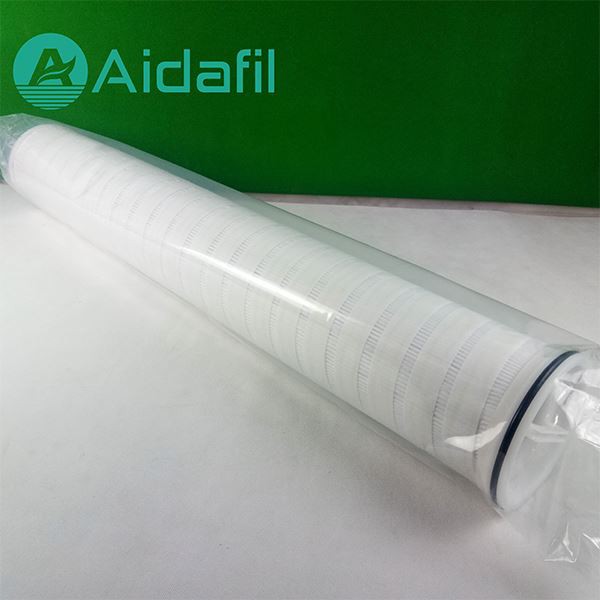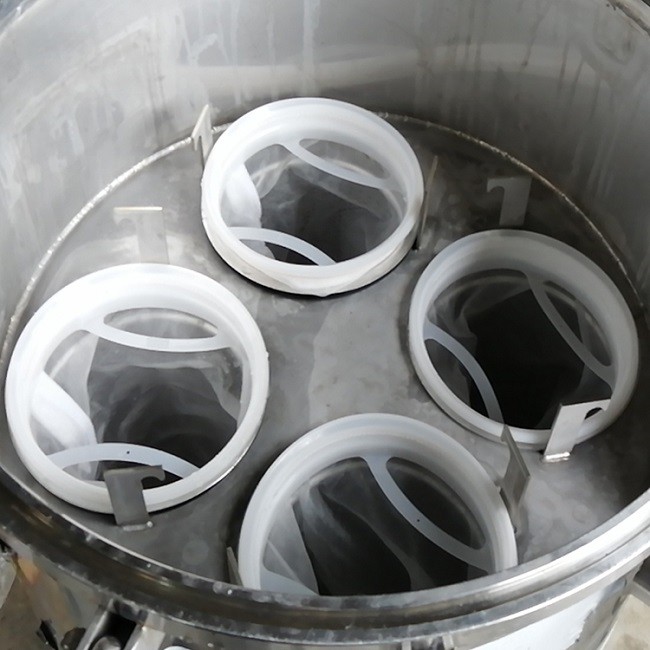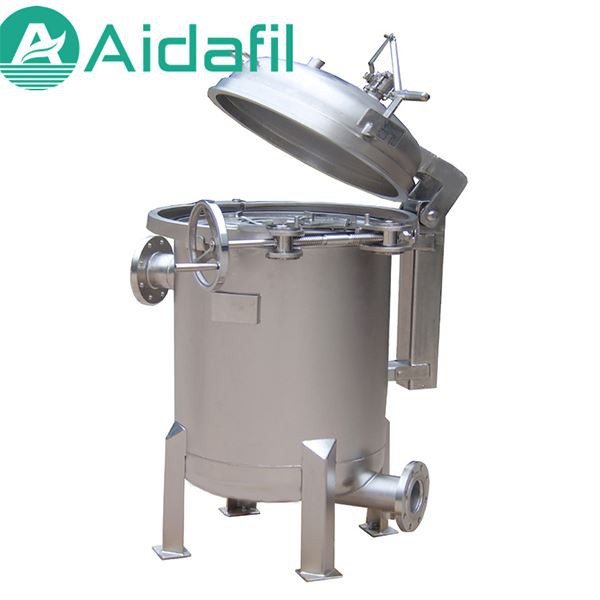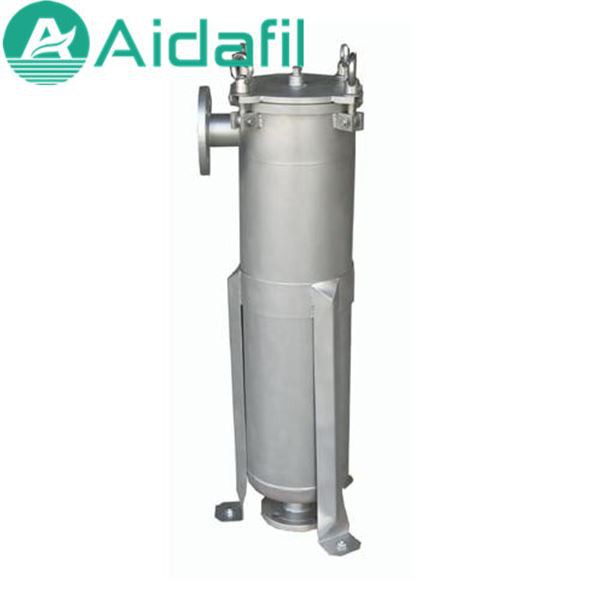About bag filters
The bag filter is a multipurpose filtration equipment with novel structure, small volume, simple and flexible operation, energy saving, high efficiency, airtight work and strong applicability. It is mainly composed of main components such as filter housing, filter cartridge cover and quick-opening mechanism, stainless steel filter bag reinforcement net, etc.
Bag filter is a new type of filter system. The filter bag is supported by a metal mesh basket inside. The liquid flows in from the inlet and flows out from the outlet after being filtered by the filter bag. The impurities are intercepted in the filter bag and can be used continuously after the filter bag is replaced.
Installation steps of the filter bag:
1. Place the bag filter on the station to be filtered, connect the inlet and outlet flanges or pipe teeth, and fix it; block the exhaust port, or configure an exhaust valve. Jacket type connection to thermal insulation heat source.
2. Gently put the metal inner mesh into the bag filter, so that the neckline of the inner mesh matches the mouth of the bag filter.
3. Place the filter bag so that the ring mouth of the filter bag matches the neckline of the metal inner mesh.
4. To put the O-shaped sealing ring into the O-shaped groove, the O-shaped sealing ring cannot be twisted or deformed, and the filter bag pressure ring is buckled on the multi-bag filter.
5. Hold the handle of the upper cover with one hand, and turn the top handwheel by holding the other end of the upper cover with the other hand.
6. After the upper cover is aligned, tighten the two diagonal suspending caps at the same time, and tighten all the suspending caps one by one with a short stick inserted into the hoisting ring.
7. Close the exhaust valve installed on the top of the bag filter.
8. Please check whether the connecting pipes are firm; whether the working pressure is within the allowable range.
9. Open the output valve. Open the heat source inlet valve, the temperature of the filter will rise to the specified temperature.
10. Slowly open the input valve, let the liquid slowly flow into and fill the filter, prevent the liquid from suddenly impacting the filter bag and cause rupture, and then observe whether there is leakage. If there are no leaks, filtration can begin.


The filter bag of the bag filter is more convenient to replace, and the filter bag can be used repeatedly after cleaning, saving costs; the bag filter has a wide range of applications, flexible use and various installation methods.
Steps to replace the filter bag
The high-efficiency filter bag is made of fine fibers, and the hydrophilicity of these materials is weak.
The surface of the fiber is not wetted by water, so like other filter element made of the same material, it must be wetted with another liquid with a lower surface tension before use. Before installation, you must immerse the filter bag in a pre-wet solution that matches the filter fluid for a few minutes.
2. Be sure to open the top cover of the bag filter.
3. Put the top cover firmly and take out the filter bag carefully.
4. To put in the new filter bag, please refer to the installation steps above.
The filter bag does not need to be replaced every time, and the replacement frequency is too high, and it is not cost-effective. Sometimes the filter bag is just blocked, and the filter bag can be reused after cleaning and other treatments.
Common faults and solutions
The damaged position of the filter bag at the bottom of the bag is mostly caused by the accumulation of material at the bottom of the equipment, and the accumulation of material is mostly caused by the failure of the equipment at the bottom of the bag filter.
Maintenance can reduce the long-term accumulation of pulverized coal materials inside the bag filter, minimize the damage to the bag, and reduce the difficulty of replacing the bag, ensuring that the maintenance can be completed in the shortest time and the process production can be resumed as soon as possible.
Damaged position of filter bag
The damaged position of the filter bag occurs in the bag and the burning loss of large beans in the cloth bag is mostly caused by the problem of material particle size and material distribution method. There are high-temperature particles of different sizes in the filtered high-temperature flue gas, and the temperature exceeds 400 degrees, which cannot be detected by ordinary temperature detectors.
Most of the particles will settle in the gravity settling chamber, and some high-temperature particles will enter the bag filter through the flue gas pipeline at a high speed with the airflow. If it is a polycondensation fiber such as polyester, polypropylene, PPS and other filter bags, when the surface of the filter bag is less dusty, the high-temperature particles will burn through the filter bag to form irregular round holes.
When there is a lot of dust on the surface of the filter bag, the high-temperature particles will not burn through the filter bag, and will form dark-colored baking marks on the filter bag. This requires the operator to strictly control the relevant process indicators in the production process to ensure that the materials meet the relevant process requirements to ensure the stable operation of the equipment.
The damaged position of the filter bag is mostly caused by the failure of the backflush system at the mouth of the bag. Excessive backflushing pressure of the bag filter and eccentricity of the injection port can lead to this situation. When this happens, the injection system of the bag filter should be checked in time, and the injection pressure and the angle of the injection port should be adjusted to ensure the stable operation of the bag filter.
Judgment method of filter bag shrinkage
Each type of bag filter material has its own special molecular composition, and the operating temperature is also very different. When the temperature limit of the filter material is exceeded, the filter bag will shrink and cannot be filtered, or even the bag cage cannot be pulled out.
A general introduction to the shrinkage of the filter bag is as follows:
(1) The bag cage in the dust collector is higher than the filter bag, sometimes on the top spray pipe, indicating that the filter bag shrinks;
(2) The bag cage in the filter bag cannot be pulled out (except for the deformation of the filter bag), indicating that the filter bag has shrunk;
(3) The bottom of the filter bag is broken by the bag cage, indicating that the filter bag has shrunk;
(4) The color of the filter bag becomes darker (except for corrosion)
Filter bag blockage and how to deal with it
(1) The main reasons for the blockage of the filter bag are that the filtration speed is too high, the dust is too fine, the dust is sticky, the filter bag is not cleaned properly, the filter bag is pasted, condensation, and hardening.
If the filtration air speed of the dust collector exceeds the design standard of the filter bag, it is easy to cause the fine dust in the flue gas to enter the inside of the filter bag fiber, and the filter bag clogging resistance will increase.
It is a better method to use film-coated filter material, coated filter material or pre-coat ash on the surface of the filter bag. For viscous dust, it is necessary to reduce the filtering wind speed, or increase the pressure of pulse injection, or adopt the method of offline pulse cleaning filter bag, but the better method is to increase the filtering area, reduce the filtering wind speed, and prolong the filter bag life service life.
(2) Poor cleaning of the filter bag mainly includes frequent cleaning times and too long cleaning time.
Excessive cleaning frequency and excessive cleaning pressure will easily loosen the fiber tissue of the filter bag and increase the fine dust in the flue gas to block the filter bag. If the cleaning time is too long, the initial powder layer on the surface of the filter bag will be washed away together, resulting in a decrease in the filtration accuracy of the filter bag.
If the cleaning time is too short, the dust on the surface of the filter bag has not been completely cleaned, and then the filtration starts, and the dust gradually accumulates on the surface of the filter bag, causing the filter bag to be blocked. Adjust the blowing controller after the test run.
(3) Moisture is the biggest cause of filter bag blockage. The cause of water content is usually condensation at low temperature.
Especially when dealing with high temperature flue gas, the following methods can be used to prevent such a situation: avoid improper startup; avoid Start when the dust collector resistance is large; start when it is lower than the dew point.
If the dust collector operates below the dew point, problems are prone to occur. If the air intake is not uniformly distributed, it is easy to cause local corrosion of the dust collector shell.
Therefore, the dust collector should be avoided to work below the dew point.
If it is unavoidable to start the machine at a low temperature, an insulation device, such as steam insulation or electric heating insulation, should be used.
(4) Air infiltration. Air infiltration often occurs in the flange of the dust collector, the access door or the movable device of the dust collector.
If the sealing is not tight, the outside air enters the dust collector. When dealing with high temperature flue gas, a low temperature area will be generated inside the dust collector, resulting in low temperature. Condensation at the place will corrode the dust collector and cause the bag to be pasted or hardened.



